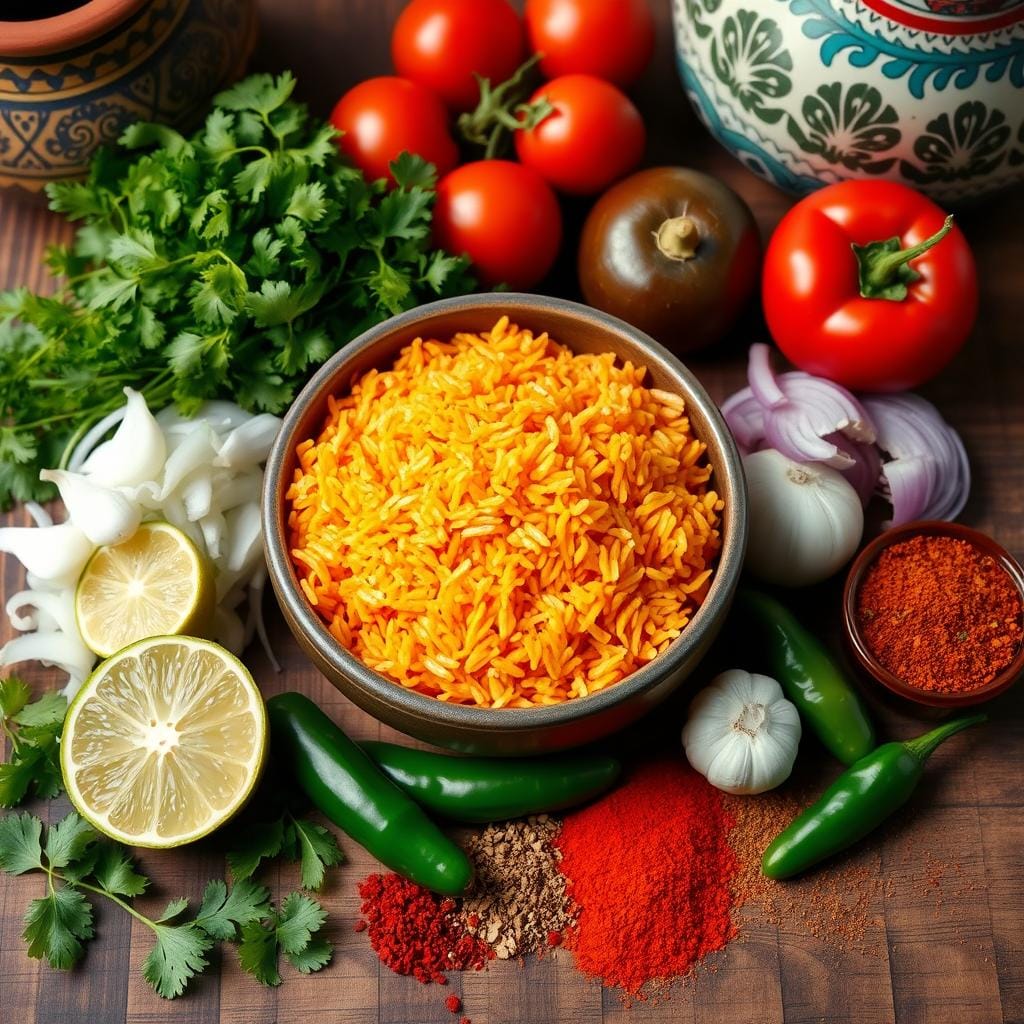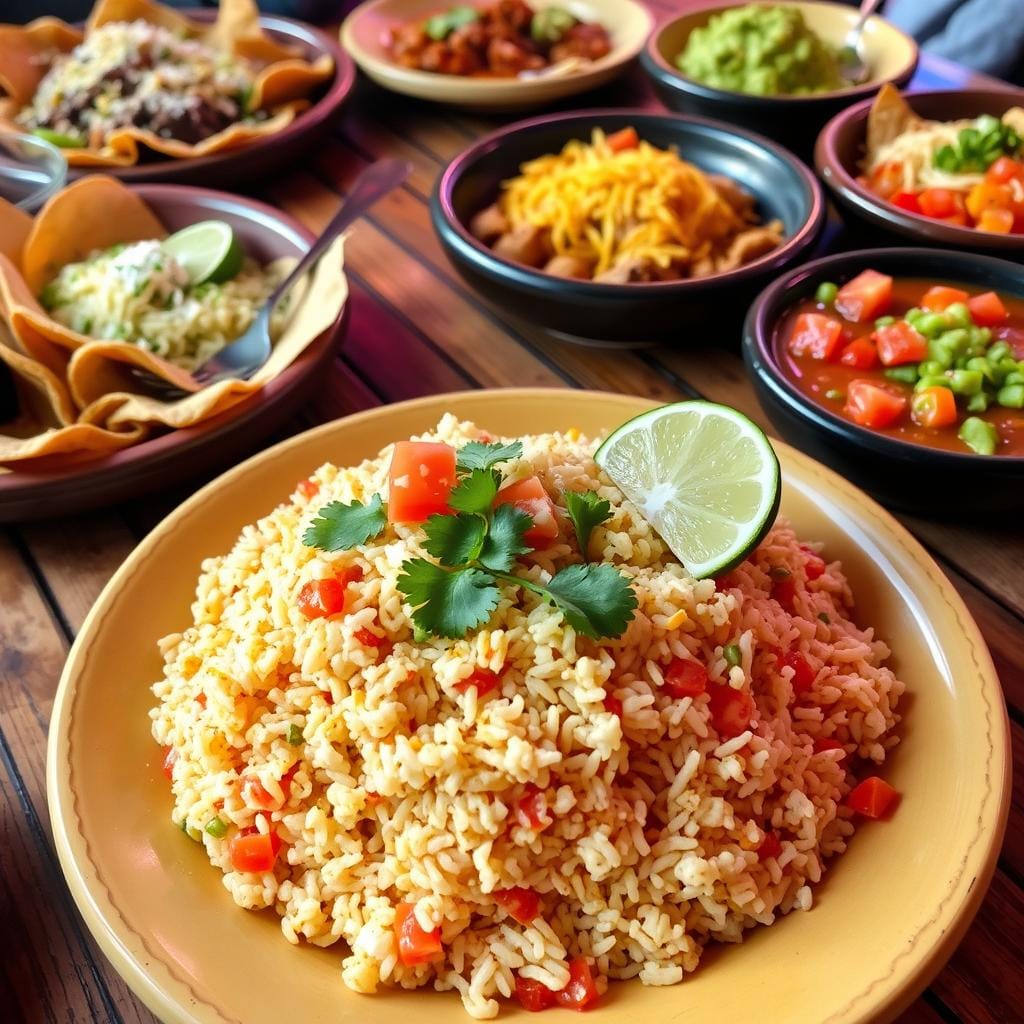Why does Mexican restaurant rice taste better? The aroma of spices and rice welcomes you as you enter, tempting you to indulge. Their rice outshines homemade versions thanks to meticulous details, traditional methods, and a commitment to authenticity.
Key Takeaways
- Discover the key components that contribute to the superior taste of Mexican restaurant rice.
- Explore the impact of professional-grade kitchen equipment on the cooking process.
- Learn about the essential ingredients and traditional cooking techniques that make Mexican rice so special.
- Understand the role of seasonings and spices in creating the authentic flavor profile.
- Uncover the common mistakes home cooks make when attempting to replicate restaurant-style Mexican rice.
The Secret Behind Restaurant-Quality Mexican Rice
Mexican rice is a key part of authentic Mexican food. It makes the meal special. The secret is in the ingredients, kitchen tools, and how much is made.
Key Components of Authentic Mexican Rice
Great Mexican rice starts with top-notch long-grain rice. Restaurants prefer Basmati or Jasmine rice for its fluffy texture. They also toast the rice, which adds a nutty smell and flavor.
Professional Kitchen Equipment Impact
The kitchen tools used in restaurants matter a lot. They use big pots, pans, and stovetops. This helps cook the rice evenly and perfectly.
Volume and Consistency Factors
Restaurants make a lot of Mexican rice at once. This helps cook it evenly. It makes the rice taste and feel just right.
| Characteristic | Restaurant-Quality Mexican Rice | Homemade Mexican Rice |
|---|---|---|
| Rice Type | Basmati or Jasmine | Long-grain or medium-grain |
| Toasting | Thoroughly toasted | Minimal or no toasting |
| Cooking Equipment | Commercial-grade pots and pans | Typical household cookware |
| Batch Size | Larger volumes | Smaller batches |
| Texture | Fluffy and distinct | Potentially uneven or sticky |

Essential Ingredients That Make Mexican Rice Special
Making the perfect Mexican rice is all about the right traditional ingredients. The type of rice and the mix of spices and seasonings are key. They make this Mexican cuisine staple truly special.
The choice of rice is crucial. Restaurants often use medium-grain or short-grain rice like Arborio or Valencia. These types are stickier and soak up flavors better. Tomatoes, onions, and garlic add a lively base. Cumin, chili powder, and oregano give it that unique aroma.
Using fresh or dried ingredients changes the rice’s taste and texture. Fresh tomatoes add a bright, tangy flavor. Dried tomatoes bring a deeper taste. Fresh garlic or dried garlic can also change the dish’s intensity.
“The key to exceptional Mexican rice lies in the harmonious balance of traditional ingredients, spices, and cooking techniques.”
Mexican restaurants carefully pick and mix these ingredients. They create a rice dish that looks great and tastes amazing. This side dish is a perfect match for the bold flavors of Mexican cuisine.

Traditional Cooking Techniques Used by Mexican Restaurants
Mexican rice is a hit because of the cooking secrets used by chefs. They toast the rice just right and mix it with the perfect amount of liquid. These steps are what make the rice taste so good.
Proper Toasting Methods
Toasting the rice is a key step. Chefs toast it until it smells nutty and looks golden. This brings out the rice’s flavor and makes it fluffy.
Liquid-to-Rice Ratio Secrets
Finding the right mix of liquid and rice is important. Chefs know just how much liquid to use. This makes the rice light and fluffy.
Temperature Control Mastery
Keeping the temperature right is crucial. Chefs watch the heat closely. They adjust it to cook the rice evenly and prevent burning.
Mexican restaurants use these techniques to make delicious rice. By learning these methods, home cooks can make great rice too.
Why Does Mexican Restaurant Rice Taste Better?
Ever wondered why Mexican restaurant rice tastes better than homemade? It’s all about quality ingredients, cooking skills, and kitchen practices.
Restaurant rice uses top-notch long-grain white rice. This rice soaks up flavors well and stays fluffy. They also add special spices like cumin, garlic, and tomato for a rich taste.
Chefs in kitchens toast the rice in oil first. This adds a nutty flavor. They also control the liquid and temperature to cook it perfectly.
Commercial kitchens can make large amounts of rice evenly. They use big pots and rice cookers. This is hard to do at home, where batches are smaller and tools are simpler.
| Restaurant-Style Mexican Rice | Homemade Mexican Rice |
|---|---|
| Premium long-grain white rice | Standard long-grain white rice |
| Carefully toasted in oil | May not be toasted |
| Precise liquid-to-rice ratio | Variable liquid-to-rice ratio |
| Consistent, uniform cooking | Potential inconsistencies |
| Industrial-sized cooking equipment | Home kitchen equipment |
Knowing the differences can help you make better rice at home. With the right ingredients and techniques, you can make rice as good as your favorite restaurant.
The Role of Seasonings and Spices in Mexican Rice
At the heart of authentic Mexican cuisine lies the careful balance of aromatic spices and seasonings. This is especially true for the flavorful rice dishes found in renowned Mexican restaurants. The interplay of these flavors is what elevates Mexican rice to a level of exceptional taste.
Traditional Mexican Spice Combinations
Mexican chefs have perfected the art of blending spices to create the signature taste of their rice dishes. Common ingredients include:
- Cumin
- Chili powder
- Garlic powder
- Onion powder
- Paprika
- Oregano
These spices work in harmony to infuse the rice with a delightful depth of flavor. They balance savory, smoky, and slightly spicy notes.
Timing of Spice Addition
The precise timing of when these spices are added during the cooking process is crucial. Mexican restaurants carefully time the addition of spices to maximize their impact. By toasting the spices before incorporating them into the rice, chefs unlock their full aromatic potential.
Fresh vs. Dried Ingredients Impact
While dried spices form the foundation of traditional Mexican rice, fresh ingredients can also elevate the dish. The addition of fresh herbs, such as cilantro or parsley, can lend a vibrant, herbaceous note. Fresh garlic and onions can also impart a more authentic, homemade taste.
The skilled interplay of spices, seasonings, and fresh ingredients is what sets apart the rice served in authentic Mexican restaurants. By understanding and replicating these techniques, home cooks can bring the flavors of Mexico to their own kitchens.
Professional Kitchen Equipment and Its Impact
Creating the perfect Mexican rice is all about the right kitchen tools. Chefs in restaurants use special equipment to make their rice taste and feel amazing. This is what sets their Mexican rice apart.
The rice cooker is a big deal. Restaurants use big, commercial rice cookers. These cookers keep the rice at the perfect temperature and moisture. This makes sure every grain is just right.
The size and material of cooking pots also matter. Chefs use big, heavy pots to sauté the rice. This helps lock in the flavors and gives the rice a unique texture.
Temperature control is key. Restaurants have advanced systems to keep the cooking temperature just right. This is hard to do at home, but it makes a big difference in the taste of the rice.
“The tools and equipment used in professional kitchens are specifically designed to handle the demands of high-volume, consistent restaurant recipes.”
With the right equipment and skills, Mexican restaurants can make rice that’s hard to beat at home. The combination of top-notch tools and chefs’ expertise is what makes their rice so delicious.
Common Mistakes When Making Mexican Rice at Home
Trying to make Mexican rice like restaurants at home can be tough. Many people face a few common problems. These issues make it hard to get that restaurant-style Mexican rice taste and texture.
Rice Selection Errors
Choosing the wrong rice is a big mistake. Many pick short-grain or medium-grain rice. But, long-grain rice is best for the right texture. It cooks up fluffy and separate, unlike short-grain rice which clumps.
Temperature Control Issues
Keeping the right temperature is another problem. Restaurants use special tools to cook rice perfectly. Without these, rice can turn out undercooked, soggy, or burnt, ruining the flavor and texture.
Seasoning Missteps
Getting the seasoning right is also tricky. The mix of spices like cumin, garlic, and onion is key. If you get the timing or amounts wrong, the dish won’t taste like restaurant rice.
By avoiding these mistakes and paying attention to rice preparation and cooking methods, you can get closer to the restaurant vs homemade taste in your kitchen.
Tips to Replicate Restaurant-Style Mexican Rice
Getting the delicious taste of Mexican restaurant rice at home is easy with the right methods and ingredients. By using authentic cooking techniques, paying close attention to details, and choosing the right rice, you can make it just like the restaurants.
- Start with the right type of rice. Look for medium-grain or long-grain varieties that are specifically labeled as “Mexican” or “Spanish” rice.
- Properly toast the rice in oil or butter before adding liquid to develop a deeper, nuttier flavor.
- Use a liquid-to-rice ratio of about 2:1 and keep a close eye on the temperature, adjusting it as needed to ensure the rice cooks evenly.
- Incorporate a variety of spices, such as cumin, garlic, and chili powder, at the right time for maximum impact.
- Invest in quality kitchen equipment, like a heavy-bottomed pan or a rice cooker, to ensure consistent results.
By following these tips and techniques, you can make your flavorful rice dishes taste like your favorite Mexican restaurant. You can enjoy it right in your own kitchen.
“The secret to exceptional Mexican rice is in the details – from the type of rice you use to the precise timing of the spices. With a little practice, you can master the art of authentic cooking techniques and create restaurant-quality results every time.”
Conclusion
The secret to delicious Mexican restaurant rice is in the details. It’s about using real ingredients and mastering traditional cooking. Now, you can make that restaurant-quality rice at home.
Choosing the right rice and controlling temperature and timing are key. Adding the right spices and cooking methods brings out the flavor. This is what makes Mexican rice so special.
Whether it’s for a family dinner or a party, you can make your Mexican rice stand out. Follow the tips from this article to enhance your rice. Enjoy the flavors and aromas that make Mexican rice so loved.

